HumBug Online
At a party I was recently asked the difference between damselflies and dragonflies. Although close relatives (order odonata) that live very similar lives, there are some differences.
Both groups spend the majority of their lives as aquatic larvae breathing water. They are all hunters but with varying specialties. Some hide in the detritus in the bottom of ponds, others swim freely like tiny fish and still others stalk prey through submerged weeds and algae.  There is, of course, an exception, possibly the most ancient group of dragonflies, the petaltails. This family, considered the most primitive, spend their juvenile years amphibiously, in wet burrows on mud banks and bogs often venturing out at night to hunt. These particular nursery requirements make them very uncommon.
There is, of course, an exception, possibly the most ancient group of dragonflies, the petaltails. This family, considered the most primitive, spend their juvenile years amphibiously, in wet burrows on mud banks and bogs often venturing out at night to hunt. These particular nursery requirements make them very uncommon.
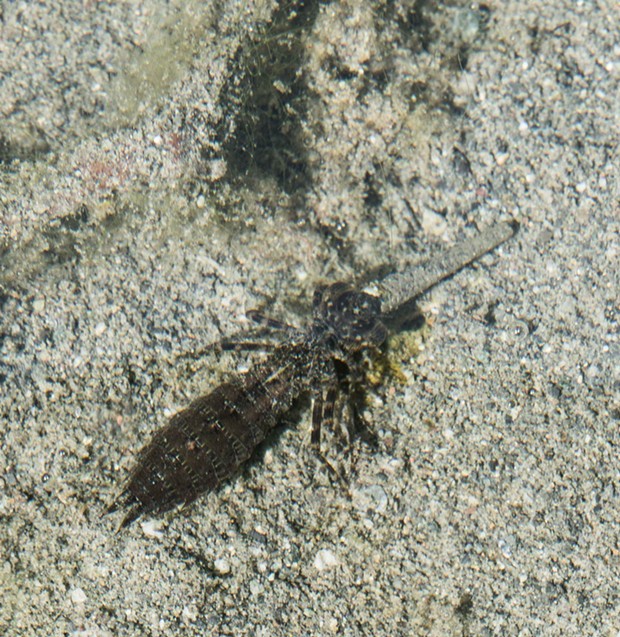
Damselflies belong to the sub order zygoptera, which essentially means “same wing,” referring to the fact that the front and hind wings are roughly the same size and shape. Their bodies are more slender, their eyes are usually shaped like commas laying on their sides and they can all fold their wings over their backs when at rest. 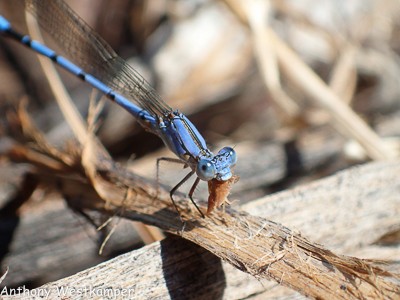
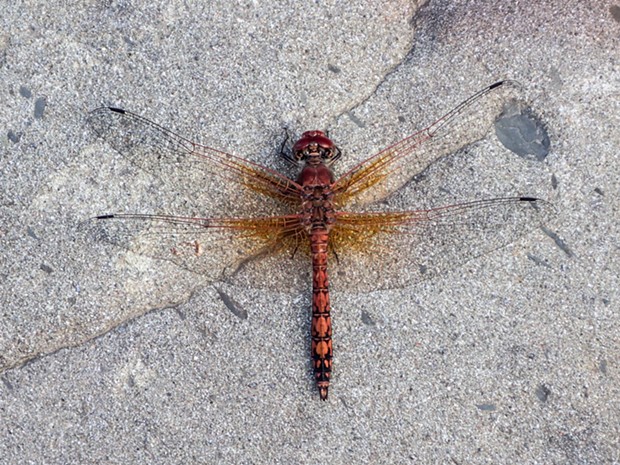
One group characteristically holds their wings out from their bodies, giving them their family name “spreadwing.” I have seen them fold them up when required on windy days.
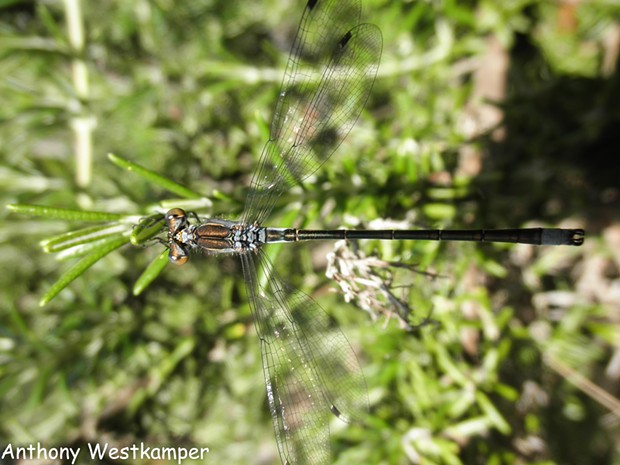
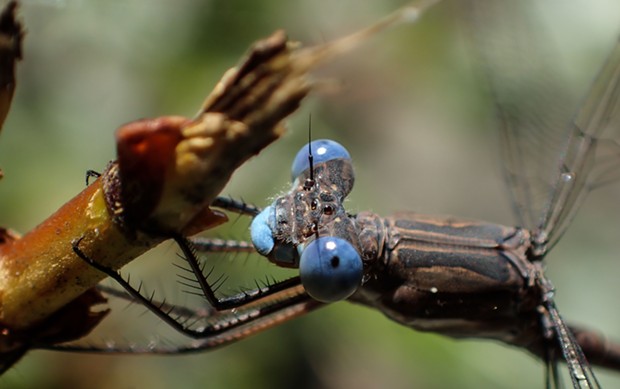 In dragonflies (sub-order anisoptera meaning “different wing”) front and back wings are shaped differently from each other and always held out flat away from their bodies when at rest. Their bodies are heavier and their eyes often cover most of their head, resembling a football helmet.
In dragonflies (sub-order anisoptera meaning “different wing”) front and back wings are shaped differently from each other and always held out flat away from their bodies when at rest. Their bodies are heavier and their eyes often cover most of their head, resembling a football helmet.
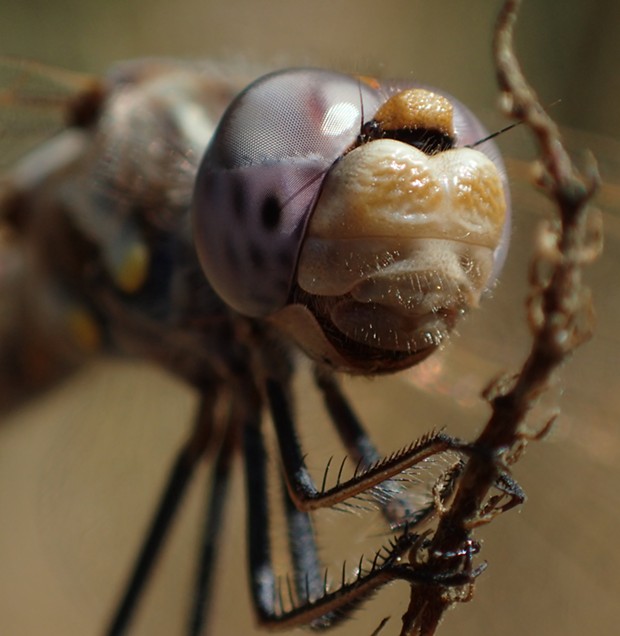 Damselfly larvae are slender and sport three petal-like gill appendages on their tail through which they breathe oxygen from the water. Some actually use them as swimming fins as well.
Damselfly larvae are slender and sport three petal-like gill appendages on their tail through which they breathe oxygen from the water. Some actually use them as swimming fins as well.
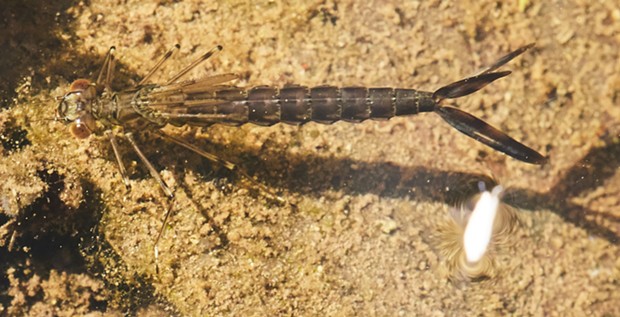
Juvenile dragonflies have no such flaps, but can dart ahead very rapidly, expelling water from their rear end like a jet boat. Being at or near the apex of the insect food chain the population and diversity of these critters can be used to gauge the health of a water course.
For more information on these beautiful and popular creatures, there are a number of references I use:
Common Dragonflies of California by Kathy Biggs. This handy pocket guide covers the vast majority of species in our state.
Dragonflies and Damselflies of California, by Tim Manolis. A moderate sized soft bound book, illustrated throughout with nice biological drawings of individual species. An old-school approach that lets the author extenuate specific characteristics.
Dragonflies and Damselflies of Oregon by Kerst & Gordon. Medium format paperback covering species known to live in Oregon. (Hint: Many members of this order have no respect for political boundaries and reside here in Norther California as well.)
Dragonflies and Damselflies of the West by D. Poulson. My copy is a large paperback volume that covers a larger area and has more information on individual species.
Dragonflies, Behavior and Ecology of Odonata by Philip Corbert. A large hardbound volume with mountains of technical information and few pictures, mostly line drawings explaining technical details. The information in this book is not limited to any specific geographic area.
And www.odesforbeginners.com is an excellent online resource for beginners.
Both groups spend the majority of their lives as aquatic larvae breathing water. They are all hunters but with varying specialties. Some hide in the detritus in the bottom of ponds, others swim freely like tiny fish and still others stalk prey through submerged weeds and algae.

- Photo by Anthony Westkamper
- Male American rubyspot damselfly.

- Photo by Anthony Westkamper
- Dragonfly larva dining on a caddisfly larva.
Damselflies belong to the sub order zygoptera, which essentially means “same wing,” referring to the fact that the front and hind wings are roughly the same size and shape. Their bodies are more slender, their eyes are usually shaped like commas laying on their sides and they can all fold their wings over their backs when at rest.

- Photo by Anthony Westkamper
- California dancer dameslfly.

- Photo by Anthony Westkamper
- Red rock skimmer dragonfly shows characteristic wing posture and shapes.
One group characteristically holds their wings out from their bodies, giving them their family name “spreadwing.” I have seen them fold them up when required on windy days.

- Photo by Anthony Westkamper
- Black spreadwing shows this damselfly family often hold their wings horizontally.

- Photo by Anthony Westkamper
- A portrait of a California spreadwing shows eye shape common to damselflies.

- Photo by Anthony Westkamper
- Variegated meadowhawk portrait showing how its eyes cover most of the uppper part of its head.

- Photo by Anthony Westkamper
- Damselfly larva, note tail paddle-like gills.
Juvenile dragonflies have no such flaps, but can dart ahead very rapidly, expelling water from their rear end like a jet boat. Being at or near the apex of the insect food chain the population and diversity of these critters can be used to gauge the health of a water course.
For more information on these beautiful and popular creatures, there are a number of references I use:
Common Dragonflies of California by Kathy Biggs. This handy pocket guide covers the vast majority of species in our state.
Dragonflies and Damselflies of California, by Tim Manolis. A moderate sized soft bound book, illustrated throughout with nice biological drawings of individual species. An old-school approach that lets the author extenuate specific characteristics.
Dragonflies and Damselflies of Oregon by Kerst & Gordon. Medium format paperback covering species known to live in Oregon. (Hint: Many members of this order have no respect for political boundaries and reside here in Norther California as well.)
Dragonflies and Damselflies of the West by D. Poulson. My copy is a large paperback volume that covers a larger area and has more information on individual species.
Dragonflies, Behavior and Ecology of Odonata by Philip Corbert. A large hardbound volume with mountains of technical information and few pictures, mostly line drawings explaining technical details. The information in this book is not limited to any specific geographic area.
And www.odesforbeginners.com is an excellent online resource for beginners.
Comments